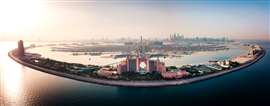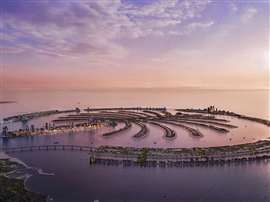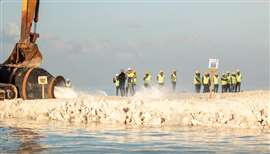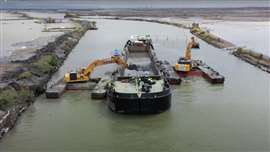Out of the blue: 7 land reclamation projects re-shaping the world
04 September 2024
Twenty years ago, Dubai’s plan to build Palm Jumeirah, a huge palm tree shaped artificial archipelago of luxury hotels and villas in the Arabian Gulf sounded too audacious to be true. Since then, the success of ambitious artificial islands like the Palm and advances in the dredging technology used to create it, have helped fuel a rush of new land reclamation projects. Lucy Barnard reports.
With its Disneyland-style pink towers and huge oriental style arch, Dubai’s Atlantis hotel has become one of the iconic images of the coastal desert city.
For the thousands of visitors who flock to the nautically themed resort each year, one of the main reasons for visiting is the hotel’s unique location, right at the apex of the Palm Jumeirah, probably the world’s most famous archipelago of artificial islands.
 An aerial view of Palm Jumeirah with Atlantis in the foreground. Photo: Adobe Stock
An aerial view of Palm Jumeirah with Atlantis in the foreground. Photo: Adobe Stock
In the first half of 2024 alone, the Palm helped Dubai attract 9.31 million international visitors.
Twenty years ago when Dutch dredging company, Van Oord was dredging up sand from the sea and trucking in loads of rocks blasted from nearby mountains, Dubai’s plans to build three huge palm leaf shaped peninsulas into the Arabian Gulf housing tens of thousands of people in luxury beachside properties (as well as an archipelago of artificial islands further out to sea in the shape of a world map) sounded too audacious to be true.
Since then, the success of ambitious artificial islands like the Palm and advances in the dredging technology used to create it, have helped fuel a rush of new land reclamation projects.
China has invested heavily in its dredging industry and has built about 200 vessels since 2006 to become one of the world’s biggest dredger manufacturers. Earlier this year China Communications Construction (CCCC) launched its Xin Hai Xun, the world’s largest dual-fuel powered trailing suction hopper dredger which has a hopper capacity of 17,000 cubic meters. And CCCC has orders in for three more ultra-large suction dredgers with capacities of 25,000, 30,000 and 35,000 cubic meters.
A February 2023 study led by Dhritiraj Sengupta, a physical geographer at the Plymouth Marine Laboratory, analysed Landsat satellite imagery from 2000 to 2020 to quantify the spatial extent, scale, and land use of urban coastal reclamation for 135 cities with populations in excess of 1 million.
It found that since the year 2000, cities around the world have used land reclamation techniques to add a total 253,000 hectares of additional land to the Earth’s surface – equivalent to an area the size of Luxembourg – driven by industrialization, a need for urban space, rising sea levels and the prestigious nature of such projects.
Marine Sand Watch, a data platform, developed by the UN environment Programme (UNEP) estimates that around a million lorry loads of sand a day are currently being extracted from the world’s oceans, totalling 6 billion tonnes of marine sand a year – something it says is “significantly impacting biodiversity and coastal communities.”
Construction Briefing looked at seven of the most high-profile land reclamation projects currently being created and the construction opportunities arising from them.
1) Palm Jebel Ali, Dubai (13.4 square kilometres)
 Artist’s impression of the completed Palm Jebel Ali. Image: Nakheel
Artist’s impression of the completed Palm Jebel Ali. Image: Nakheel
Spanning an area of 13.4 square kilometres – roughly twice the size of Palm Jumeirah, Palm Jebel Ali which is located off the coast of Dubai in the Jebel Ali area of the city, originally began construction in 2002 and was expected to be completed by 2008 but stalled after the global financial crisis with 95% of the land reclamation completed.
The project, which is similar in design to Palm Jumeirah but 50% larger project is expected to add about 110 kilometres of coastline to Dubai and include 35,000 homes as well as 80 hotels and resorts.
In 2023, the Dubai government approved a relaunch of the project and in May 2024, Nakheel announce it had awarded contracts for the construction of infrastructure on the island to DBB Contracting and Khansaheb Civil Engineering. In August 2024 the company announced it had awarded Belgian dredging company Jan de Nul Group a two-year contract to complete the dredging, land reclamation, beach profiling and sand placement on the project to support the construction of villas on the new island.
2) Dalian Jinzhou Bay International Airport, China (21 square kilometers)
Set to be completed in 2026, Dalian Jinzhouwan International Airport is set to become the world’s largest offshore airport.
The project, which is currently being built on a 21-square-kilometre artificial island close to the city of Dalian in northeast China will eventually handle a total of 70 million passengers and 1.5 million tons of cargo a year. A first phase of the airport will include two runways and a 500,000 square meter terminal building. A second phase will add two more runways and another 400,000 square meter terminal complex.
First announced in 2012, the new airport will replace Dalian Zhoushuizi International Airport which is constrained on all sides.
In October 2023, state media Xinhua published a series of aerial photographs showing that construction work had started on the new island.
3) Ras Malé, Maldives (11.5 square kilometres)
 Construction work taking place atr Ras Male in December 2023. Photo: Housing Development Corporation
Construction work taking place atr Ras Male in December 2023. Photo: Housing Development Corporation
As the lowest lying country in the world, the Maldives is one of the nations most exposed to the effects of global warming.
In response, since the 1990s, the government of the island nation has embarked on an ambitious shore protection and land reclamation plan, dredging up sediment from the ocean floor to build new islands less vulnerable to rising sea levels.
In December 2023, President Mohamed Muizzu officially inaugurated the start of construction work on Ras Malé, an 11.5-square-kilometre project located in Fushi Dhiggaru Lagoon, close to the Maldivian capital Malé, which will be elevated two meters at its edges and three meters at its centre (higher than most of the land in the country). The project, which is also known as the Maldives Eco City, is the country’s largest land reclamation project to date. Muizzu said it will eventually include 65,000 homes and run entirely on renewable energy, from transport to its infrastructure and facilities.
At a press conference in March 2024, the Maldives minister for construction and infrastructure said that reclamation work on the mega project was not yet underway due to a lack of sand. Nonetheless, he added the work on a bund wall for the project was underway.
4) Eko Atlantic, Lagos, Nigeria (9 square kilometres)
Officially known as Nigeria International Commerce City, Eko Atlantic is a 9-square-kilometre land reclamation project in front of Bar Beach in the Nigerian city of Lagos often described as “the Dubai of Africa.”
The project is being carried out as a public private partnership between private investors including Nigerian real estate company, South Energyx Nigeria Limited, part of the Chagoury Group and the Lagos State Government.
Aimed at preventing coastal erosion and providing 250,000 homes as well as hotels and offices, dredging started in 2009. The project is buttressed by a sea wall to prevent flooding. In 2013 a lavish ceremony including former US president Bill Clinton. The first skyscrapers at the site have been completed.
Originally earmarked for a 2025 completion date, local media reports suggest this has slipped to 2040.
5) Long Island, Singapore (8 square kilometres)
In 2003, Singapore announced potential plans for an 8-square-kilometre land reclamation plan stretching from Marina East to Tanah Merah, which would eventually create a freshwater reservoir in front of East Coast Park. The project, which was originally proposed in 1991 is designed to protect the city state from flooding the effects of rising sea levels.
Technical studies will start from 2024 and be carried out over the next few years.
6) New Manila International Airport, Philippines (6.9 square kilometres)
 SMC dredging teams dredge rivers close to the future site of the New Manila International Airport in January 2024. PhotoL San Miguel Corporation
SMC dredging teams dredge rivers close to the future site of the New Manila International Airport in January 2024. PhotoL San Miguel Corporation
New Manila International Airport is currently under construction on 6.9 square kilometers of land, much of which is being reclaimed from the sea in the province of Bulacan, 20 kilometres north of central Manila.
The Philippines’ Department of Transportation (DOT) signed a 50-year concession agreement with San Miguel Aerocity, the infrastructure unit of multinational conglomerate San Miguel Corporation (SMC), in September 2019 to construct the airport on a build-operate-transfer (BOT) basis.
Land reclamation on the new airport commenced in 2019 and construction is expected to be completed in 2027. The airport will be developed in phases, with an initial capacity of 35 million passengers a year and 100 million upon full completion.
Land development works including site preparation and earthworks began in the first quarter of 2021. The ground platform is being developed in 12 phases requiring an estimated volume of approximately 150 million cubic metres of ‘borrowed materials.’
Dutch dredging specialist Royal Boskalis Westminster (Boskalis) was awarded a €1.5 billion ($1.8 billion) contract to undertake land development work in December 2020. The scope of work includes preparing the land platform, creating access channels, a temporary berthing facility, and an offshore disposal area.
In March 2024, San Miguel said that it aimed to start construction work on the airport in 2025 and that progress for the land development work was at 77%.
7) Lynetteholm, Denmark (1.1 square kilometres)
 An artist’s impression of what Lynetteholm will one day look like. Image: Reuters
An artist’s impression of what Lynetteholm will one day look like. Image: Reuters
One of Europe’s most ambitious and controversial climate projects, Lynetteholm is a 271-acre (1.1 square kilometre) man-made peninsula in the Øresund Strait, currently being built by By & Havn, a company jointly owned by the Copenhagen Municipality and the Danish government.
The main aim of the project is to shield the low-lying city of Copenhagen, from rising sea levels. So far officials have only approved the island building phase of the project but it is expected that eventually the new area will include 35,000 new homes by 2070.
Approved by politicians in 2021, construction work on the 50-year project began a year later. Danish construction company Per Aarsleff has been awarded a contract to work on the marine aspect of the project. It has appointed Rohde Nielsen to undertake some dredging and sand filling. Denmark-based Munck Havne & Anlǽg is constructing an access road.
STAY CONNECTED



Receive the information you need when you need it through our world-leading magazines, newsletters and daily briefings.
CONNECT WITH THE TEAM








